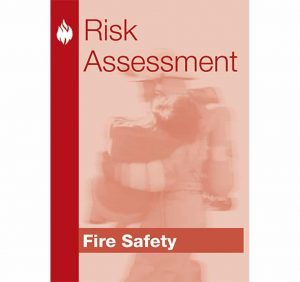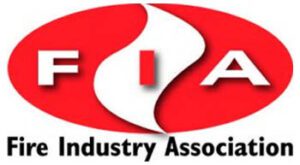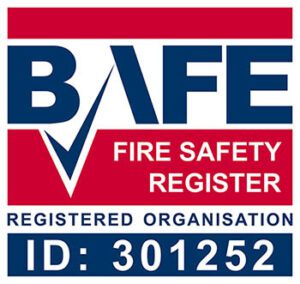All business premises and every block of flats must have a Fire Risk Assessment by law.
Not everyone understands this important fire safety measure.
We are often asked the question ‘what is a Fire Risk Assessment?’. The fact is, your Fire Risk Assessment should be the cornerstone of your fire safety plans for your specific building.
Unfortunately, assessments are often overlooked, which can lead to buildings being exposed unnecessarily to fire risk, sometimes with the potential for loss of life.
You can read more about Fire Risk Assessments below, or otherwise please get in touch with our expert team if you would like to discuss the specific requirements for your building.
 1. So, what is a Fire Risk Assessment?
1. So, what is a Fire Risk Assessment?
At the most basic level, it is a review taken of a building to assess it for fire risk, and to provide recommendations to make it safer if need be.
A Fire Risk Assessment does not have to be written down if there are fewer than 5 regular occupants in a building, so it is not necessarily a document.
However, we would always recommend having a Fire Risk Assessment written down, as this is the simplest way to communicate the findings and to make sure that the recommendations have been carried out.
What are the legal guidelines around assessments?
There are some specific guidelines concerning Fire Risk Assessments.
1. It must be reviewed regularly. We recommend to review as follows:
– At 12 monthly intervals following the original assessment
– NB A brand new assessment should be carried out every 5 years
– If the fabric of the building has changed e.g. the layout has altered
– If the purpose of the building has altered substantially
– If the nature of the occupants has changed considerably
Changes in the layout of the building, the use of it, or the type of occupant can make a big difference to your fire safety plans, so it’s important to conduct a Fire Risk Assessment review if any of these take place.
2. It must be written down if there are 5 or more regular occupants.
If your business premises or block of flat usually has more than 4 residents at any one time, then you must legally document your Fire Risk Assessment.
However, as already mentioned, we would always recommend having your assessment written down whatever the size of your premises.
There are a couple of other circumstances in which your Fire Risk Assessment must be written down even if you have fewer than 5 regular occupants. These are:
– If the premises need a licence or
– The fire brigade has instructed you to (following a visit, for example)
3. It must record the main findings and the actions to be taken
Whether written down or not, there are 2 parts to a Fire Risk Assessment that must be produced.
One is the review itself, which will assess the fire safety of the premises against a number of points.
The other is the list of recommendations which should be acted on for the building to be fire safety compliant.
It is so important to act on these recommendations because ultimately this is what will keep your building safe.
Who is responsible for making sure a Fire Risk Assessment is carried out?
By law, every business and block of flats must have a designated ‘Responsible Person’, accountable for fire safety.
It is the designated Responsible Person’s job to make sure the relevant fire safety duties are carried out and that action is taken to prevent fires happening, and also to prevent injury or death if a fire does actually happen.
It is therefore the Responsible Person who should make sure your building has a valid Fire Risk Assessment.
If you are a small business owner, you are generally the Responsible Person for your premises, unless you have nominated someone in your team.
If you are a resident in a block of flats or tower block, then the Responsible Person is typically the landlord or managing agent, although they may also be a member of the Residents’ Association.
In blocks of flat the Responsible Person is only accountable for the common areas, such as corridors and stairwells. It is up to the resident to make sure their own flat is fire-safe.
How can I get a copy of my building’s Fire Risk Assessment?
It is absolutely your right as an occupant of a building to have access to your premises’ Fire Risk Assessment if you choose.
Your first port of call should be the Responsible Person for your building. If you’re not sure who this is, then the business owner, the facilities department, the landlord or managing agent would be good places to start.
If you find that your building doesn’t have a valid Fire Risk Assessment, then you should request that your Responsible Person has one carried out as soon as possible.
If you feel that you are not having your concerns treated seriously by your building’s Responsible Person, then, as a last resort, you could get in touch with your local fire brigade.
However, please don’t contact the fire brigade with trivial concerns, they are busy people. And of course, do not use the 999 emergency number! You will be able to find your local fire brigade’s general enquiries number on the internet.
What gets reviewed?
Fire Risk Assessments should be comprehensive and take into account many different fire risk factors.
The level of detail in an individual review will depend to a large extent on the complexity of the building. For example, a ‘single-compartment’ building, such as a small shop or kiosk, will have far less to review than a large office block, or even a block of flats.
Whilst every assessment is different, the assessor should be checking the following fire risk and fire prevention factors as a matter of course:
1. The use, layout, and construction of the building
2. The number and nature of occupants, including any vulnerable occupants
3. Whether there is any history of fire loss in the building
4. Electrical equipment on site which could be a source of ignition
5. Smoking areas and measures taken to prevent smoking causing fires
6. Defence against arson
7. Portable and installed heating devices which may trigger fires
8. Protection against fires caused by lightning
9. General housekeeping & keeping key areas clear of combustible materials
10. Any fire hazards introduced by building works or outside contractors
11. The storage arrangements for any dangerous/flammable liquids
12. The configuration of escape routes and how they are maintained
13. Measures in place to limit fire spread, such as compartmentalisation
14. That emergency lighting is installed correctly & is in working order
15. The correct use and locations of fire safety signs
16. There is adequate means of raising the alarm in case of fire (see our blog article: ‘do I need a fire alarm‘)
17. The right fire extinguishers are in the right locations (see our blog article: ‘‘fire extinguisher regulations‘)
18. The correct installation and maintenance of other devices, such as sprinklers
19. Who manages fire safety for the building, and how well
20. Whether there is regular fire safety training & evacuation drills
21. Correct maintenance and testing procedures of fire safety systems are in place
22. That correct documentation and records of fire safety measures are being kept
Who can carry out a Fire Risk Assessment?
Legal guidelines state that a Fire Risk Assessment can be carried out by a ‘competent person’. This does not necessarily mean you have to use a qualified Fire Risk Assessor.
However it does mean that whoever carries out your Fire Risk Assessment should be comfortable assessing your premises against all of the factors listed above.
They should also be able to:
– Record all the significant findings clearly and in detail
– Develop a fire safety action plan if changes are needed and record the actions
– Implement the action plan if one is needed
– Keep the fire risk assessment updated on an ongoing basis
For all but the most simple of premises, we would really recommend using a professional Fire Risk Assessor.
Professional Fire Risk Assessors undertake a lot of very detailed training and will be fully versed in the latest legal requirements and guidelines, including how to apply them to different types of building.
What is the penalty for not having a Fire Risk Assessment?
The penalty for not having a Fire Risk Assessment and, in particular, not having implemented the correct fire safety precautions, is prosecution resulting in severe fines, or in cases of extreme negligence, a prison sentence.
We hope this guide explaining ‘what is a Fire Risk Assessment?’ has been useful to you.
If you would like to talk to our expert team about your business premises, tower block or block of flats, or if you would like to book a Fire Risk Assessment from one of our expert assessors, please call us on 0800 157 1113, or email us at info@surreyfire.co.uk.



